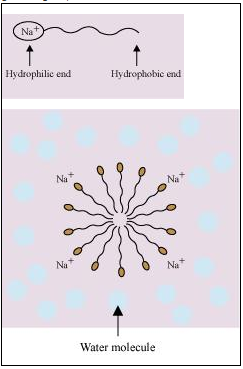Class 12 Chemistry - Chapter Surface Chemistry NCERT Solutions | What are micelles? Give an example of a
What are micelles? Give an example of a micellers system.
Micelles formation is done by substances soaps and detergents when dissolved in water.The Molecules of such substances contain a hydrophobic and a hydrophilic part. when present in water, these substances arrange themselves in spherical structure in such a manner that their hydrophobic parts are present towards the centre, while the hydrophilic parts are pointing towards outside (as shown in the given figure). This is known as micelles formation.

More Questions From Class 12 Chemistry - Chapter Surface Chemistry
- Q:-
Explain what is observed
(i) When a beam of light is passed through a colloidal sol.
(ii) An electrolyte, NaCl is added to hydrated ferric oxide sol.
(iii) Electric current is passed through a colloidal sol?
- Q:-
Why is adsorption always exothermic?
- Q:-
What do you mean by activity and selectivity of catalysts?
- Q:-
What modification can you suggest in the Hardy-Schulze law?
- Q:-
Explain the following terms:
(i) Electrophoresis
(ii) Coagulation
(iii) Dialysis
(iv) Tyndall effect.
- Q:-
What is an adsorption isotherm? Describe Freundlich adsorption isotherm.
- Q:-
Explain the terms with suitable examples:
(i) Alcosol
(ii) Aerosol
(iii) Hydrosol
- Q:-
How are colloids classified on the basis of
(i) Physical states of components
(ii) Nature of dispersion medium and
(iii) Interaction between dispersed phase and dispersion medium?
- Q:-
Discuss the effect of pressure and temperature on the adsorption of gases on solids.
- Q:-
Why does physisorption decrease with the increase of temperature
Popular Questions of Class 12 Chemistry
- Q:-
For the reaction R → P, the concentration of a reactant changes from 0.03 M to 0.02 M in 25 minutes. Calculate the average rate of reaction using units of time both in minutes and seconds.
- Q:-
Write the formulas for the following coordination compounds:
(i) Tetraamminediaquacobalt (III) chloride
(ii) Potassium tetracyanonickelate(II)
(iii) Tris(ethane-1,2-diamine) chromium(III) chloride
(iv) Amminebromidochloridonitrito-N-platinate(II)
(v) Dichloridobis(ethane-1,2-diamine)platinum(IV) nitrate
(vi) Iron(III) hexacyanoferrate(II)
- Q:-
(i) Write structures of different isomeric amines corresponding to the molecular formula, C4H11N
(ii) Write IUPAC names of all the isomers.
(iii) What type of isomerism is exhibited by different pairs of amines?
- Q:-
Why are solids rigid?
- Q:-
Write the structures of the following compounds.
(i) α-Methoxypropionaldehyde
(ii) 3-Hydroxybutanal
(iii) 2-Hydroxycyclopentane carbaldehyde
(iv) 4-Oxopentanal
(v) Di-sec-butyl ketone
(vi) 4-Fluoroacetophenone
- Q:-
Which of the ores mentioned in Table 6.1 can be concentrated by magnetic separation method?
- Q:-
Why are pentahalides more covalent than trihalides?
- Q:-
Silver atom has completely filled d orbitals (4d10) in its ground state. How can you say that it is a transition element?
- Q:-
Glucose or sucrose are soluble in water but cyclohexane or benzene (simple six membered ring compounds) are insoluble in water. Explain.
- Q:-
Write structures of the following compounds:
(i) 2-Chloro-3-methylpentane
(ii) 1-Chloro-4-ethylcyclohexane
(iii) 4-tert. Butyl-3-iodoheptane
(iv) 1,4-Dibromobut-2-ene
(v) 1-Bromo-4-sec. butyl-2-methylbenzene
Recently Viewed Questions of Class 12 Chemistry
- Q:-
Name the common elements present in the anode mud in electrolytic refining of copper. Why are they so present ?
- Q:-
Among the isomeric alkanes of molecular formula C5H12, identify the one that on photochemical chlorination yields
(i) A single monochloride.
(ii) Three isomeric monochlorides.
(iii) Four isomeric monochlorides.
- Q:-
What are food preservatives ?
- Q:-
A cubic solid is made of two elements P and Q. Atoms of Q are at the corners of the cube and P at the body-centre. What is the formula of the compound? What are the coordination numbers of P and Q?
- Q:-
Write structures of the products of the following reactions:
(i)

(ii)

(iii)

- Q:-
Explain the difference between Buna-N and Buna-S.
- Q:-
Arrange the following in increasing order of their basic strength:
(i) C2H5NH2, C6H5NH2, NH3, C6H5CH2NH2 and (C2H5)2NH
(ii) C2H5NH2, (C2H5)2NH, (C2H5)3N, C6H5NH2
(iii) CH3NH2, (CH3)2NH, (CH3)3N, C6H5NH2, C6H5CH2NH2.
- Q:-
A reaction is first order in A and second order in B.
(i) Write the differential rate equation.
(ii) How is the rate affected on increasing the concentration of B three times?
(iii) How is the rate affected when the concentrations of both A and B are doubled?
- Q:-
Give equations of the following reactions:
(i) Oxidation of propan-1-ol with alkaline KMnO4 solution.
(ii) Bromine in CS2 with phenol.
(iii) Dilute HNO3 with phenol.
(iv) Treating phenol with chloroform in presence of aqueous NaOH.
- Q:-
Describe the oxidising action of potassium dichromate and write the ionicequations for its reaction with:
(i) iodide
(ii) iron
(II) solution and
(iii) H2S
2 Comment(s) on this Question
the detergent in water
Example sir..
- All Chapters Of Class 12 Chemistry
- All Subjects Of Class 12
